Are you considering board and batten bathroom walls? I have seen pictures of board and batten feature walls all over the internet and social media. I’ve seen them done in bedrooms, living rooms, and hallways, but I think they are really underutilized in bathrooms. Follow along as I add a board and batten wall in my bathroom, creating a cozy and stylish space.

This project is incredibly cost effective, especially considering the significant impact it has. I built this board and batten bathroom wall for less than $75 in materials.
Tools
- Table saw
- Miter saw
- Drill
- 7/8″ drill bit
- Handheld sander
- Jig saw
- Laser level
- T-Square
- Brad nailer
- Stud finder
- Small level
- Paint brush
Materials
- 4 x 8 sheet of 1/4″ plywood
- 1 x 6 board
- 1 x 8 board
- 1 x 2 trim boards
- Shaker Pegs
- Stain
- Polycrylic
- Wood glue
- Lint free rags
- Paper towels
Cutting and Prepping the Wood
One of the biggest cost savers of this project is that I am using 1/4 inch plywood for the “board” on my board and batten bathroom wall. Plywood is cheap and once it’s stained, no one will be able to tell it isn’t a nicer piece of wood.
After measuring the bathroom wall to which I was going to add the board and batten, I knew exactly how big I needed my sheet of plywood to be. Using my T-Square I drew a nice straight line where I needed to cut my panel.

Using my table saw I made the necessary cuts to rip this 4×8 sheet of plywood to the right size. It can be tricky to maneuver the large sheet of plywood through the table saw by yourself, especially since this 1/4″ plywood is a little floppy. You may want to enlist the help of a friend for this part.
When you’re at the hardware store purchasing your plywood, you could get the wood cut for you right there. Just ask an employee about it, and make sure you know exactly what dimensions you need your wood cut before you go to the store.


In addition to the sheet of plywood on the back of my board and batten bathroom wall, I needed to cut some trim pieces to use for the battens (the vertical pieces of trim). I was also going to be using a couple of boards for a peg rail and cap at the top, as well as some baseboard for the bottom of the wall.
A miter saw is not just for cutting mitered corners. It’s my go-to tool for cutting trim and other narrow boards down to length. Using the miter saw is so much faster and easier than feeding them through the table saw.

For pegs on my peg rail I bought a pack of classic looking shaker pegs from the hardware store. To attach them to the board for a peg rail, I am using a drill bit the same size as the peg to make a hole for the pegs to sit in.

After marking out where each peg would go, I used my drill to make the holes.


Staining the Wood for the Board and Batten Bathroom Wall
Now that all of the wood was cut and the holes for the pegs were made, I was ready to stain all of the pieces for my board and batten bathroom wall.
The challenging part of using wood stain for this project rather than just painting it all is that I’m using three different types of wood. The sheet of plywood, the wood for the trim, and the shaker pegs are all different types of wood, which means there’s potential they’ll accept the stain differently and not turn out the same color. So first thing, I had to test my stain.
I’m using Minwax brand stain in the color Early American. I love this color and have used it in multiple projects from the legs of a faux marble coffee table to a floating mantel. It’s just a great, all around, warm wood tone – not too dark and not too light.


After testing the stain on a piece of the trim as well as a scrap piece of the plywood, I could see right away that the stain was not resulting in the same color on both pieces of wood. They looked completely different and I was going to have to do some more testing.

I decided to try diluting some stain with polycrylic, which is a clear sealant. In the photo below, the first try was straight stain. All the swatches after that are a mix of stain and polycrylic. My second try had the most polycrylic, then third section had less polycrylic and more stain, then finally the fourth swatch was mostly stain with just a bit of polycrylic. I was really happy with the color of the fourth swatch, but it still just wasn’t matching up to the color of the trim. We were getting close, but it still wasn’t a perfect match.
My next idea was sanding before staining.

And look, you can see here on the very last test section of the board, I finally get a super duper close match of color between the trim and the plywood. For that winning section, all I did was sand the plywood and then use the same mixture of stain and polycrylic that I had applied to the fourth swatch on my test board.
Sanding ended up being the key here. Prior to sanding, the plywood was just way too porous and was accepting too much stain, making it too dark compared to the trim. After sanding, I was seeing much more consistent color results.

Unfortunately, this meant that I had to sand the entire piece of plywood that I was going to use for my board and batten bathroom wall. My handheld sander made pretty quick work of it, and thankfully I didn’t have to sand any of the other boards.

Now, I could apply my stain. You want to use a basic paint brush to apply the stain, then have a box of these lint free rags close by for wiping the stain.


The technique for staining is the same whether you are applying the stain to a big sheet of wood, just on these trim boards, or even on the little pegs. Brush the stain on, then wipe with a lint free rag.


Once everything was stained, I could move on to assembling my board and batten bathroom wall.
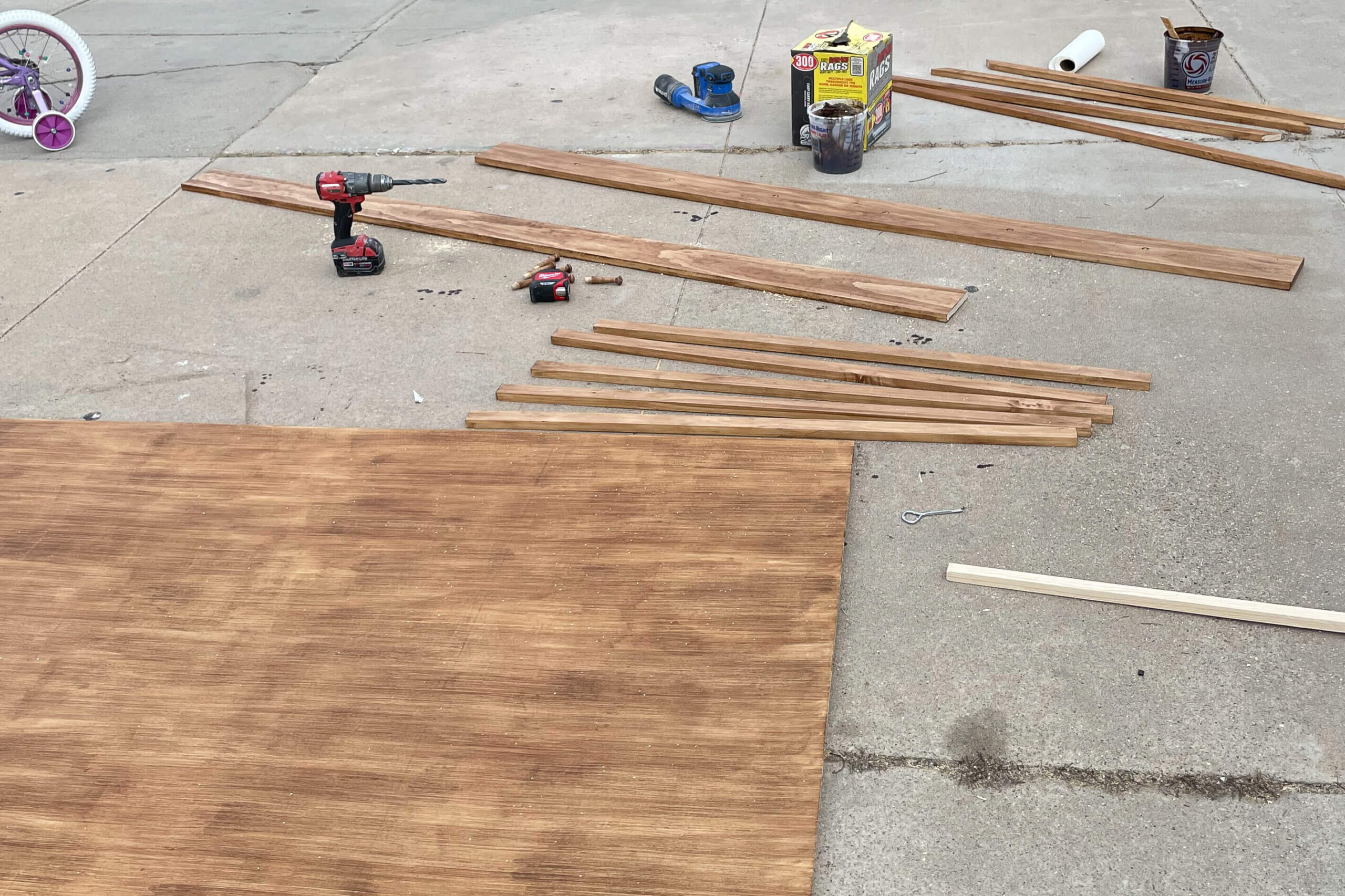
Assembling a Board and Batten Bathroom Wall
Step One – Attach the Plywood to the Wall
A laser level is really the way to go here. Houses are rarely (pretty much never) built perfectly straight. So you can’t assume that your floor is level or that the walls are straight. It’s best to use a laser level to determine exactly where you want your board and batten bathroom wall to sit, then hang the plywood at that height.

Use a brad nailer to attach the plywood to the wall. You need to use a stud finder to locate the studs. This is way too much weight to just attach to drywall. You’ll want to make sure that your brad nails are sinking into the wall studs.

On my wall, I have a vent, which I obviously couldn’t just cover with plywood. I used my jig saw to cut out a hole for the vent, then added a basic white vent cover to finish it cleanly.

Step Two: Adding Baseboard
I wanted a chunky baseboard sitting at the bottom of this board and batten bathroom wall which unfortunately would also be blocking the vent. Before attaching the baseboard I marked where my vent was, and used my jig saw to cut out a space to go around the vent.


Once that was cut out, I added stain to the freshly cut edge, then I used my brad nailer to attach the baseboard to the plywood sheet behind it.

Step Three – Install a Peg Rail
I love making things that are both beautiful and functional. So not only will this board and batten bathroom wall look amazing in here and add some style and warmth, it’s also going to have functional pegs that’ll be able to hold towels.

This peg rail piece is sitting flush with the top of the board, but rather than just eyeballing it, it’s a good idea to use a small level to make sure that you’re setting the board straight as you use a brad nailer to attach it to the plywood.

Along the top of the peg rail, I attached a piece of trim as a cap. This little ledge on the top helps give our board and batten bathroom wall a finished appearance. This way, you won’t see the seam between the peg rail and the plywood.

Now, it was time to add the shaker pegs into the holes that I’d drilled earlier. It’s much easier to put a bit of wood glue in the hole and then press the shaker peg in.

You can use a paper towel to wipe up any excess glue that squeezes out.

Step Four – Adding Battens
It wouldn’t be board and batten without the battens, which is the technical name for the vertical trim pieces that we’re attaching to the board.

Using my level, I made sure they were nice and straight before attaching them with my brad nailer.

And done! This looks so good! You would seriously never know that it is just cheap, basic plywood behind the trim.
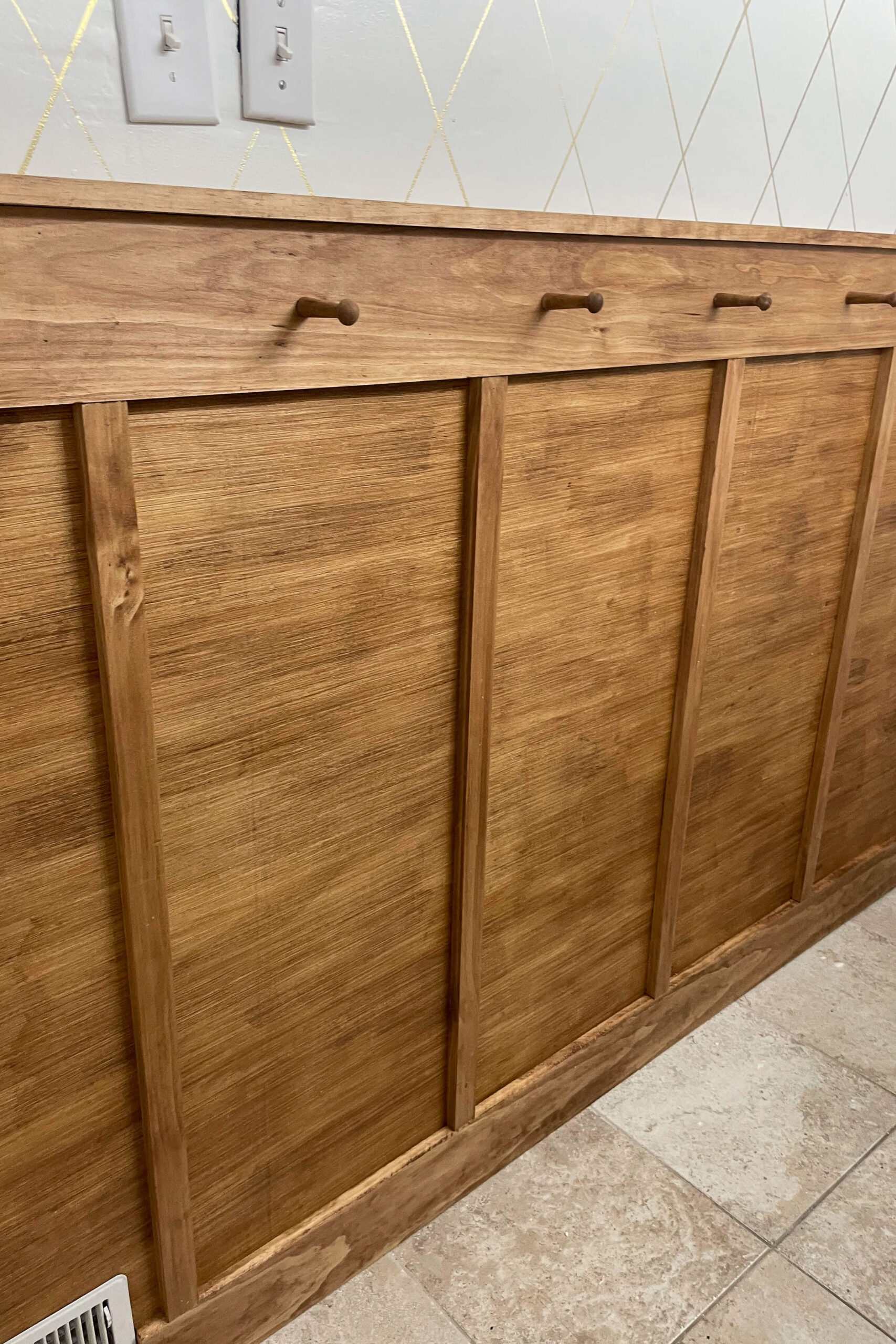
I can’t believe what a difference it makes in the bathroom. Even though matching the stain was a little bit of extra work, I love the natural looking wood tone here. I used the same stain for the bathroom mirror frame that I made in this bathroom as well. I love how cohesive the two pieces look together.
This board and batten bathroom wall is definitely the wow factor when you walk into this bathroom.

Want links to some of the other projects I did in this bathroom? I did a budget bathroom makeover and completely transformed this space for less than $500. Just look at that before photo! I painted the shower tiles, used a gold colored sharpie as “wall paper”, transformed the countertops into faux marble, updated the vanity by making new doors, built a custom wood frame for the mirror, and more.
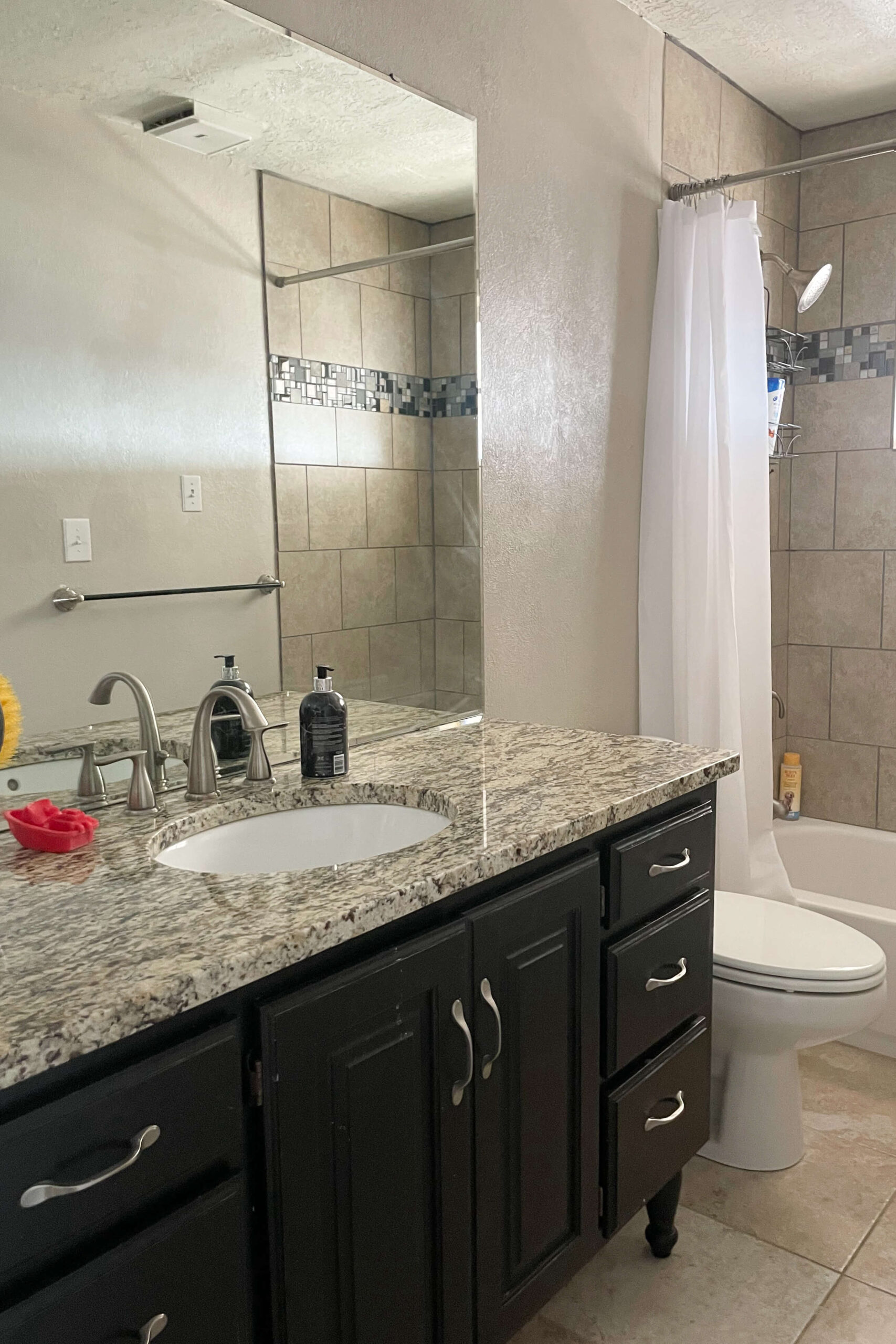
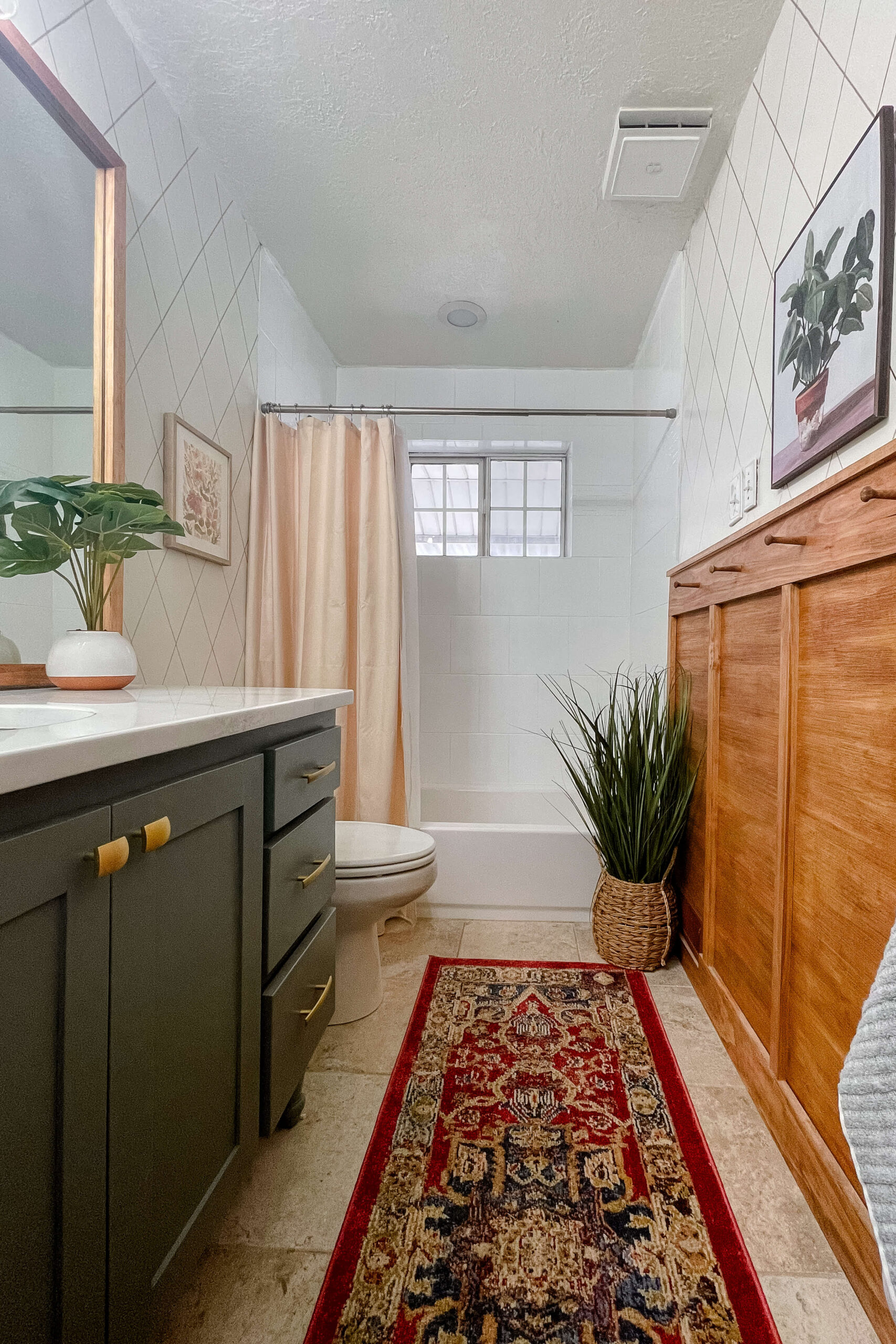
This is why I love DIY. You can truly transform your home into the space of your dreams without spending a fortune.


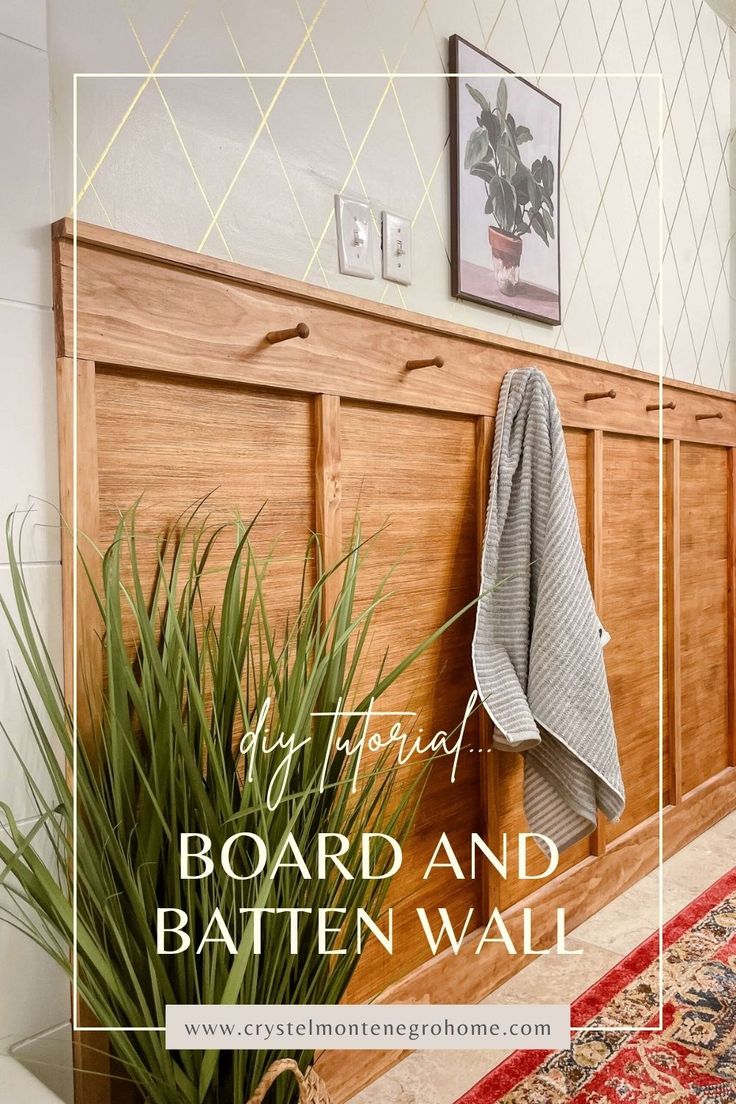
Hey! Love this and planning to do it in my bathroom.
Did you use wood filler to cover your nail holes and them up with stain? I’ve only ever painted my wood projects and so I am not familiar with the technique. Thanks for any tips you may have.
Yes! There’s a stainable wood filler that you can find at a home improvement store. There are also different colors of wood filler you can use to match your stain.